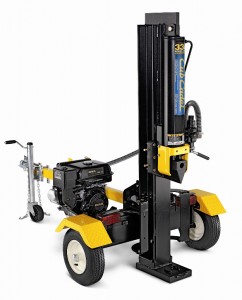 Any device that can put enough pressure on a chunk of wood to make it split is bound to do some serious damage if used incorrectly, and in some cases, the possible causes of injury aren’t obvious. These tips will help you use your Cub Cadet log splitter safely when you get firewood ready this winter.
Any device that can put enough pressure on a chunk of wood to make it split is bound to do some serious damage if used incorrectly, and in some cases, the possible causes of injury aren’t obvious. These tips will help you use your Cub Cadet log splitter safely when you get firewood ready this winter.
Use Square Pieces of Wood
The logs need to be flat on the top and bottom to be steady on the bed and when the wedge first makes contact. When you cut the firewood, make straight cuts against the grain to get the right surface for the splitter.
Read the Manual
Cub Cadet doesn’t just throw in some safety instructions to make their products lawyer-friendly: the instructions are based on testing with your specific model. If you want to use your equipment as safely as possible, heed their warnings.
Wear the Right Clothing
Safety glasses and gloves are a must, as are non-slip shoes. Hearing protection is also a good idea: the engine is the same type of engine found in a lawnmower, and it’s just as noisy, resulting in permanent hearing damage after prolonged exposure. Loose clothing and jewelry should be avoided since these items can get caught in the machinery.
Do a Thorough Inspection Before Use
Along with the usual mechanical and engine checks, particular attention should be paid to the hydraulic system. The full force of the splitter’s engine is used to drive a hydraulic pump that creates the pressure needed to push the wedge through wood. If there’s even a tiny leak in the hoses or fitting, the fluid will escape with tremendous force. That doesn’t just reduce the equipment’s power; the stream of fluid can be so forceful that it can penetrate the skin, resulting in blood poisoning.
Position the Splitter
There should be no chance of wobbling when operating the splitter, as a little shaking can mean dropping a log, damaging the splitter, or finding your hand going under the wedge. Like any device with an internal combustion engine, the splitter should be used outdoors away from buildings to prevent buildup of deadly carbon monoxide.
Use the Splitter to Reduce Lifting
Moving heavy logs can be hard on your back. Depending on your model, you may be able to adjust the bed position to better fit the natural motion of your body, whether it means less lifting or less bending over. Even on fixed models, switching between vertical and horizontal cutting may make the difference between an easy job and an injured back.
Make Sure the Bed is Locked
Cub Cadet splitters are designed to be used horizontally or vertically. To keep the bed from shifting, check the locking pin to make sure it’s fully inserted.
One Splitter = One Operator
It’s surprisingly common for accidents occur when two or more people are working around a log splitter. Sometimes it’s a matter of one person lowering the wedge onto the helper’s hand, a splinter that flies off during the split, or just a log falling out of the machine on someone’s foot. If someone is helping you out, make sure they’re at least 10 feet away from the splitter before you use it.
If someone is in the general vicinity and isn’t helping out, they’re probably not paying attention to the splitter, increasing the chance of injury. Kids, pets, and other bystanders should be kept at least 20 feet away from the splitter during use.
Reading the Wood and Adjusting the Split
The wedge should be cutting with the grain, and it needs to clear any knots that are in the log. If you need to make an adjustment, move the wedge completely out of the wood before touching anything: trying to dislodge the wood by hand could close the split, trapping your fingers.
Keep Your Log Splitter in Top Condition
A fully functioning splitter is a safe splitter. If you need parts for your Cub Cadet log splitter, visit www.cubparts.com. We’re a certified dealer for Cub Cadet and Honda small engine equipment, so we have OEM replacements for every part of your equipment. We can ship whatever you need to any address in the U.S. and Canada.
